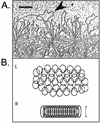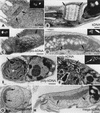Kinetoplast DNA network: evolution of an improbable structure
- PMID: 12455998
- PMCID: PMC117999
- DOI: 10.1128/EC.1.4.495-502.2002
Kinetoplast DNA network: evolution of an improbable structure
Figures





References
-
- Borst, P. 1991. Why kinetoplast DNA networks? Trends Genet. 7:139-141. - PubMed
-
- Breunig, A., G. Brugerolle, K. Vickerman, H. Hertel, and H. König. 1993. Isolation and ultrastructural features of a new strain of Dimastigella trypaniformis Sandon 1928 (Bodonina, Kinetoplastida) and comparison with a previously isolated strain. Eur. J. Protistol. 29:416-424. - PubMed
Publication types
MeSH terms
Substances
Grants and funding
LinkOut - more resources
Full Text Sources

